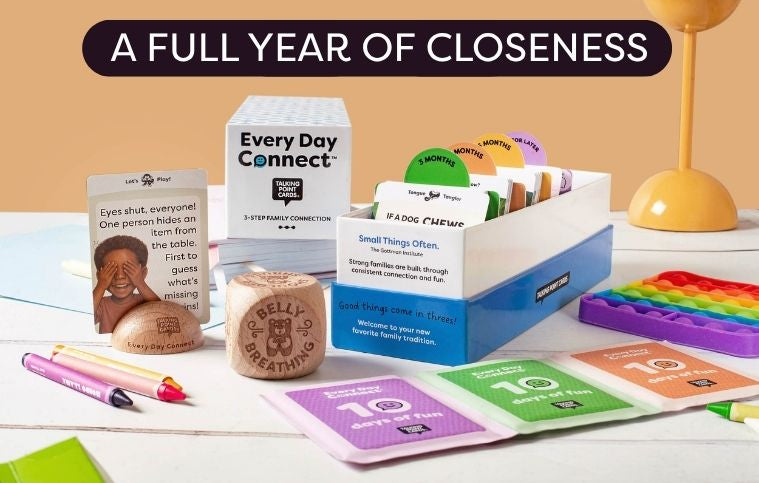SHOP
About

How To Start a Conversation With a Stranger
March 05, 2024 8 min read
Picture this: you’re at a bustling cafe, sipping your favorite brew, and suddenly, you notice someone reading an intriguing book. Now, picture another scenario; you’re at a social gathering, surrounded by many fresh faces discussing exciting new ideas when unexpectedly, you catch someone discussing a business venture you’ve been interested in for years. In both cases, there’s one catch - you’re not sure how to break the ice.
Striking up a conversation with a stranger can feel like stepping into uncharted territory sometimes. But fear not! Welcome to the ultimate guide on mastering the art of starting conversations with strangers! Keep reading as we navigate the ins and outs of initiating conversations with ease and confidence. Whether you’re a seasoned social butterfly or a wallflower, we will uncover the secrets to making all kinds of connections - from casual encounters to meaningful exchanges.
Key Takeaways
- Initiating conversations with strangers might seem daunting, but it's like opening a surprise gift box—full of potential joy and surprises waiting to be discovered.
- Conquering fears of rejection and awkwardness is part of the journey. Embrace rejection as a stepping stone toward finding meaningful connections.
- Learning to read body language and verbal cues helps gauge openness to conversation. Respect boundaries and know when to exit a conversation gracefully.
- Keep exploring conversation starters and techniques to make interactions with strangers easier and more meaningful with Talking Point Cards.
Overcoming the Initial Hesitation
Wondering how to start a conversation with a complete stranger can be intimidating due to the many fears and barriers you might have at the back of your mind. But who says you can’t tackle those pesky fears and barriers that keep you from diving headfirst into conversations with strangers?
The most common mental barrier while socializing is the classical fear of rejection, the ever-looming dark cloud in the sky of social interaction.
So, embrace the possibility of rejection like an adventurous explorer chasing rainbows. Make some small talk and dive headfirst into the conversation. What’s the worst that’s going to happen?
The Art of the Opening Line
Crafting the perfect opening line requires finesse, creativity, and just a dash of uniqueness. So, here’s how to start a good conversation with a stranger.
Context Is Your New Best Friend
Just like choosing the right seasoning for your dish, context is crucial when coming up with the perfect opener. You must consider the setting, the mood, and the vibe of the situation. You can’t exactly walk into a sports bar and ask someone their opinion on Shakespeare.
Keep It Open-Ended
The key to a good conversation is asking open-ended questions. Basically, open-ended questions are the ones where a person can’t just say a simple yes/no as an answer. These forms of openers will allow the other party or parties to share their thoughts, experiences, and dreams. In addition to that, this helps avoid conversation roadblocks like “Do you like pizza?” - spoiler alert: the answer will always be yes, and your conversation will take the easy way out.
One thing that you can try here is something called the Ping-Pong Method of conversation. Basically, you ask someone a question and they answer. Next, instead of making small talk, ask them another question related to their answer. This encourages back-and-forth communication and allows both parties to contribute effectively instead of yes/no answers. Here’s a video by Practical Psychology that explains this concept brilliantly.
https://www.youtube.com/watch?v=YoZLa-lGGH8
Spice It Up With a Pinch of Personality
Yes, everyone likes vanilla ice cream, but it’s the toppings that make it interesting. So, inject a bit of uniqueness and add a part of your personality to the opening statement - this can be a playful pun, a quirky observation, or a heartfelt compliment.
With these tips, you can craft opening lines as warm and inviting as a hot chocolate on a winter’s night. Explore Talking Point Cards Essential conversations for more ideas on conversation starters that can make initiating talks with strangers easier and more meaningful. With a sprinkle of uniqueness and a dash of spiced-up personality, you’ll be starting interesting conversations in no time!
Reading Social Cues
Reading social cues is a fun story in itself - where every smile, nod, and raised eyebrow tells a story waiting to be understood. Here are a few tricks to read the vibe of the person standing across the room.
Body Language
Picture a scenario: You approach someone with a friendly hello, and they respond with a smile and an open-armed posture, facing you. This is a clear sign that the other party is receptive to your conversation and wants to engage. On the flip side, if someone’s posture shows closed-off behavior, arms crossed, eyes darting around - it might be a sign that they might not want to engage in a conversation at the moment.
Verbal Cues
Verbal cues play the symphony of a person’s energy. So, pay close attention to someone’s tone of voice, the words they choose, and the way they respond. If they’re enthusiastic, asking follow-up questions, and sharing personal experiences, it’s a green light to keep the conversation flowing. However, if the responses are short, monotonous, or curt, it might be time to bow out gracefully or, in a few minutes, you might not have the option to do it gracefully.
Respecting Boundaries
Respecting boundaries is like knowing how to dance. It is important to learn your partner’s cues; know when to follow their lead, when to spin, and when to dip. If you sense someone isn’t interested in the conversation or seems distracted, gracefully end the dialogue with a simple “It was lovely to chat with you.” Remember, it’s all about making positive connections!
Recognizing Your Exit
The art of a graceful exit is one to learn! Knowing when to wrap things up is important, whether it’s the fact that the conversation has run its course or you sense that the other is ready to move on to other things. We suggest you look for signs that might indicate that the energy has started to wane. Then, bid your farewell on a positive note with warmth and sincerity - leaving the door open for future interactions.

Finding Common Ground
Finding common ground is important because it lets you know what to talk about. If you have no idea about the person’s likes and dislikes, you’ll be limited to very generic stuff that everyone is supposed to like. But, if you can find some common ground like a sport you both like, an author you both read, or a band you both love, that’s a sure way to have a decent conversation.
If you’re having trouble figuring out what to talk about or unsure about their interests, you need some help! Explore Talking Point Cards, more specifically the Small Talk pack, for more ideas on making small talk that can help you start up a thoughtful conversation with a stranger. These are questions that are specifically designed to promote conversation between two people who might not know each other that well.
Practicing Active Listening
Practicing the sweet melody of active listening is an art on its own. This practice is the secret ingredient to building bridges and forging connections.
Mirroring the other party’s body language, facial expressions, and tone of voice is the gentlest way of saying, “I see you, I hear you, I’m right here in this safe space with you.” You can also give the other party positive verbal confirmations like “That’s so awesome” or “Tell me more!” Better yet, throw in some non-verbal cues as well, like nodding your head, smiling, and an unbreakable eye contact.
Remember, active listening isn’t just about hearing words; it’s about tuning in and dialing up the empathy dial by truly understanding and connecting with the person in front of you.
Sharing Personal Stories
Sharing personal stories with someone you've just met is like opening a door to your world and inviting them in for a quick peek. It's about saying, "Hey, this is me, and here's a little bit of my journey."
When you share a piece of your life, you're not just filling the silence; you're laying down a bridge for connection. It's fascinating how a simple story can spark a genuine conversation, turning awkward silences into moments of laughter, empathy, or even a shared sigh of understanding. It’s like finding common ground in a forest of strangers.
And the cool thing? The person you’re talking to often feels the vibe and shares a bit of their story too. Before you know it, you're no longer strangers but two people discovering the joy of a new friendship.
Embracing the Learning Experience
Living a day at a time and letting go of the daily tension without hanging on to one thing for a long time is why happy people don’t fall into the dark pits of depression. Stepping into a river and finding your way out is the same as conversing with different strangers; you never know where the path is going to end.
The learning experience makes stepping into the unknown worth it. Moreover, you also get to know about people’s heartbreaks and their stories. This builds empathy and gives you tons of exposure to how people behave and the psychology of different people.
However, for many people, the realization of tomorrow is limited by our doubts of today. But getting into that river is pretty exciting, right? Stepping in is the only way to say goodbye to social anxiety, get the joy of getting out alive, and taste the sweetness of victory!
Conclusion
There you have it! The transformative potential of engaging with strangers through the magic of conversation! Trust us; each interaction is like a seed planted, waiting to bloom and blossom into beautiful connections and new horizons. So, embrace the challenge with open arms and try it out. What’s the worst that can happen? They’ll walk off? No harm no foul!
With that said, if you feel like your conversations are a little bit lackluster and need a bit of an upgrade, check our Talking Point Cards! We have a bunch of packs that people can use to spice up their conversations. Here are three reasons why Talking Point Cards are your best friend when it comes to improving conversations!
FAQs
Is It Weird To Start a Conversation With a Stranger?
Starting a conversation with a stranger isn't weird; it's a chance to connect, learn, and grow. It's about sharing human experiences and finding common ground. While it may feel daunting, it's a step towards understanding others and expanding our own worldviews. Embrace it as an opportunity, not an oddity.
What If I Run Out of Things to Say?
If you run out of things to say, embrace the pause. Use it to ask questions, show genuine interest in the other person's responses, or share observations about your surroundings. Silence can be a moment to reflect and find new topics. Remember, effective listening is as impactful as speaking.
How Can I Tell If Someone Wants to Talk?
To gauge if someone wants to talk, observe their body language and responses. Open posture, eye contact, and engaged reactions suggest interest. Conversely, short replies, lack of eye contact, or closed body language indicate disinterest. Respecting these cues ensures meaningful conversations and respects personal boundaries.
Is It Rude to Start a Conversation With a Stranger?
Starting a conversation with a stranger isn't inherently rude; context and approach matter. If done respectfully and with awareness of social cues, it can be a positive, enriching experience. Being mindful of the situation and the other person's openness to engage ensures that the interaction is welcomed, not intrusive.






